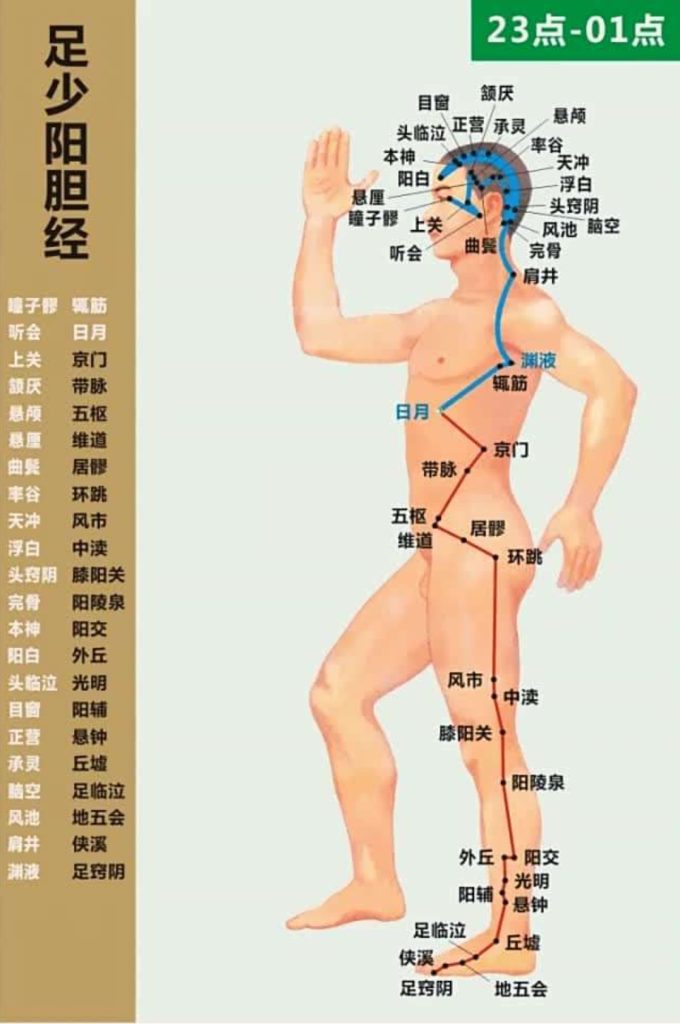- Although the meridians appear to be just some channels (rivers) on the surface of the human body on the meridian diagram, these meridians all have branches in the trunk that enter the body and the internal organs. The following table shows the connection between the main meridians and internal organs:
- 11pm-1am Foot Shaoyang —- Gallbladder
- 1am-3am Foot Jueyin —- Liver
- 3am-5am Hand Taiyin —- Lungs
- 5am-7am Hand Yangming —- Large Intestine
- 7am-9am Foot Yangming —- Stomach
- 9am-11am Foot Taiyin —- Spleen
- 11am-1pm Hand Shaoyin —- Heart
- 1pm-3pm Hand Taiyang —- Small Intestine
- 3pm-5pm Foot Taiyang—- Bladder
- 5pm-7pm Foot Shaoyin —- Kidney
- 7pm-9pm Hand Jueyin —- Pericardium
- 9pm-11pm Hand Shaoyang —- Sanjiao
As can be seen from the above table, the main internal organs of the human body are all connected with a certain meridian. Therefore, if there is a problem with a meridian (for example, the meridian on the surface of the body is hurt by cold or damaged by a virus), it may affect the corresponding internal organs (the meridian gets sick first and the internal organs later). Conversely, if the internal organs are sick (such as pneumonia), the corresponding meridians will also be affected, and eczema, allergies, blisters, etc. may appear on the skin. (Of course, the strength of the Qi flowing in the meridian will also change or fluctuate greatly at this time, and our instrument uses this principle to measure and assist in diagnosis).

A very important concept here is the concept of Qi. Qi is an important nutrient in the human body. These substances are pumped by the activity of the lungs to run in the meridians. They can not only provide nutrients to various internal organs and the brain, but also generate heat to keep the human body warm. If the meridians are viewed as rivers connected in series (divided into 12 sections), then Qi is the flowing water in the river. According to the theory of traditional Chinese medicine, Qi flows continuously in the meridians, and it can flow in a circle every 28.5 minutes. If for some reason (such as the damage by COVID-19 or blood stasis), the Qi cannot flow smoothly, people may feel cold for a while and hot for a while, or feel hot at regular intervals (every half hour). At this time, acupuncture can be used to dredge the meridians.
In addition, due to the influence of the disease, the different components (Yin and Yang) of the Qi in the meridians may be out of balance, or the strength of the Qi between the different meridians may be out of balance. At this time, acupuncture can be used to achieve the balance of different components or the balance of strength between different meridians. For example, if the acupuncturist thinks that the Qi in lungs are deficient, they can pierce at the stomach or spleen meridians(downstream) to temporarily stop the flow of Qi so that the lungs can get more nutrition.
Finally, we should also know that different internal organs are excited at different times, injecting different nutrients into the Qi circulation (Something like rain belt moves to different sections of a river depending on the season). For example, the lungs work hard between 3am-5am. If the COVID-19 virus caused lung damage, the flow of Qi starts to fluctuate at that time, then the person will feel this change and wake up at this moment. This is a common cause of insomnia caused by the COVID-19.